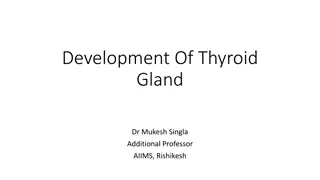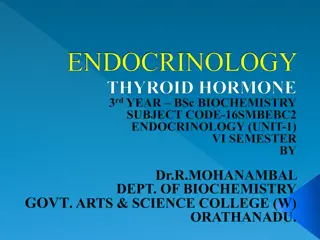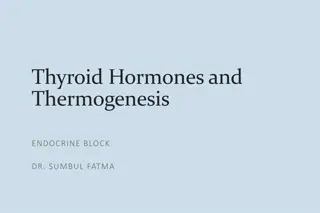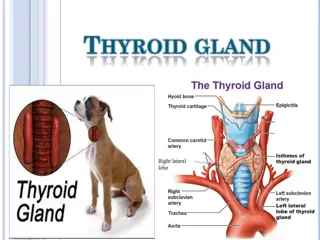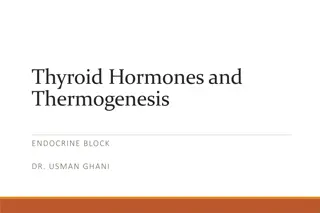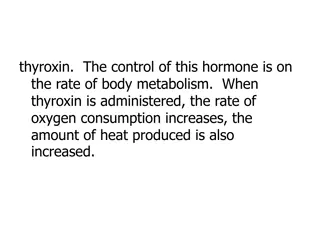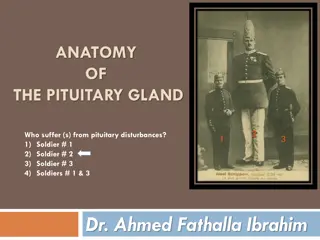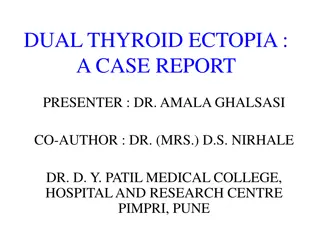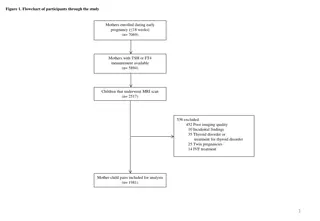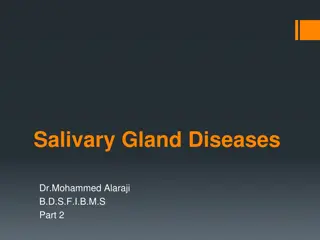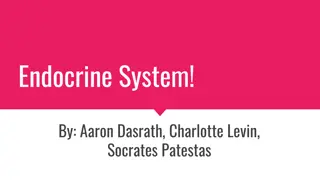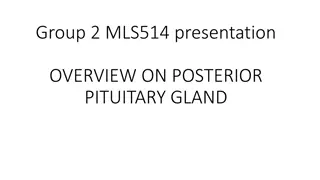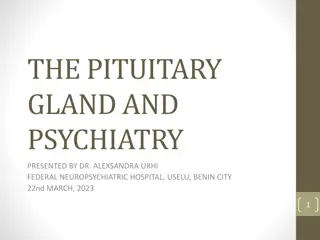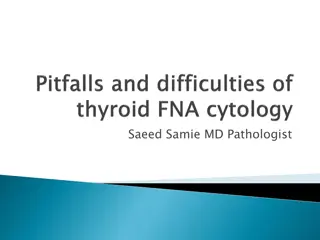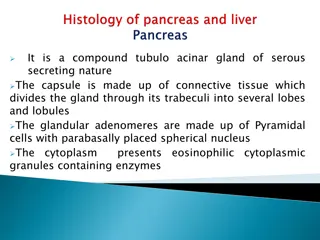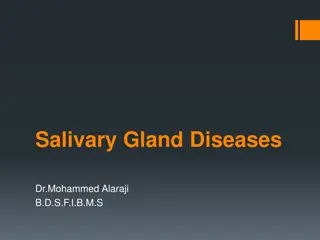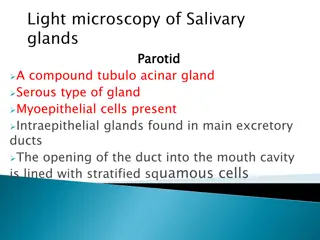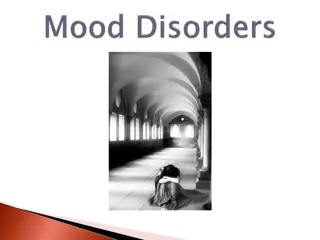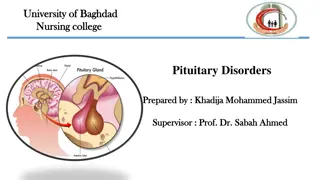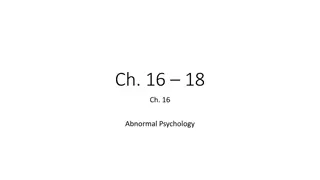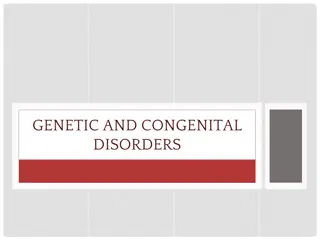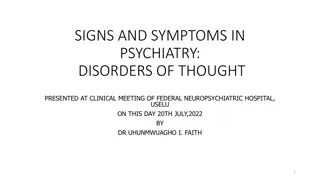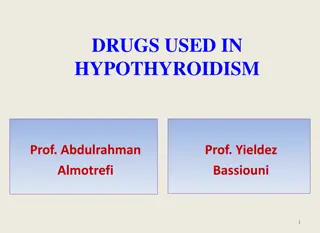Understanding Disorders of the Thyroid Gland: Group 2 Presentation
The thyroid gland, a vital part of the endocrine system, produces hormones that regulate metabolic processes, energy expenditure, and tissue growth. Dysfunction of the thyroid can lead to various disorders affecting overall health. Learn about the functions of thyroid hormones, diagnostic tests, and the importance of maintaining thyroid hormone levels for optimal body functions.
Download Presentation

Please find below an Image/Link to download the presentation.
The content on the website is provided AS IS for your information and personal use only. It may not be sold, licensed, or shared on other websites without obtaining consent from the author. Download presentation by click this link. If you encounter any issues during the download, it is possible that the publisher has removed the file from their server.
E N D
Presentation Transcript
Disorders of the thyroid gland Group 2 presentation
Group members Akintoye Olamitoyosi E. Ayinde Waliat Odunayo 17/MHS02/019 17/MHS02/028 Akpene Emuesiri Heubert Bakare Bosola opemipo 17/MHS02/021 17/MHS02/029 Akpiroroh Efe Bamisaye Mary Odunayo 17/MHS02/022 17/MHS02/030 Akuboubi .C. Jennifer Benard Ehi Faith 17/MHS03/006 17/MHS02/031 Animashaun Faith Adedoyin Bobola Praise 17/MHS02/023 18/MHS02/200 Awodoyin Omolabake K. Busari .O. Zainab 17/MHS02/026 17/MHS01/088 Awulu Mary Inikpi Chidera Chuks Anah 17/MHS02/027 17/MHS02/103
Introduction The thyroid gland is the part of the endocrine system. It is a butterfly shaped organ, located anterior to the trachea, just inferior to the larynx. Produces three hormones-Thyroxin, Triodothyronine and calcitonin which regulates metabolic process, cellular respiration, total energy expenditure, growth and maturation of tissues, and turnover of hormones, substrates, and vitamins. Functions of the Thyroid hormones. The thyroid hormones, T3 and T4, are often referred to as metabolic hormones because their levels influence the body s basal metabolic rate, the amount of energy used by the body at rest. When T3 and T4 bind to intracellular receptors located on the mitochondria, they cause an increase in nutrient breakdown and the use of oxygen to produce ATP. In addition, T3 and T4 initiate the transcription of genes involved in glucose oxidation.
FUNCTIONS OF THYROID HORMONES CONT. Although these mechanisms prompt cells to produce more ATP, the process is inefficient, and an abnormally increased level of heat is released as a byproduct of these reactions. This so-called calorigenic effect (calor- = heat ) raises body temperature. Adequate levels of thyroid hormones are also required for protein synthesis and for fetal and childhood tissue development and growth. They are especially critical for normal development of the nervous system both in utero and in early childhood, and they continue to support neurological function in adults. Finally, thyroid hormones increase the body s sensitivity to catecholamine (epinephrine and norepinephrine) from the adrenal medulla by up regulation of receptors in the blood vessels. When levels of T3 and T4 hormones are excessive, this effect accelerates the heart rate, strengthens the heartbeat, and increases blood pressure.
Diagnostic Tests Anti-TPO antibodies: In autoimmune thyroid disease, proteins mistakenly attack the thyroid peroxidase enzyme, which is used by the thyroid to make thyroid hormones. Thyroid ultrasound: A probe is placed on the skin of the neck, and reflected sound waves can detect abnormal areas of thyroid tissue. Thyroid scan: A small amount of radioactive iodine is given by mouth to get images of the thyroid gland. Radioactive iodine is concentrated within the thyroid gland. Thyroid biopsy: A small amount of thyroid tissue is removed, usually to look for thyroid cancer. Thyroid biopsy is typically done with a needle. Thyroid stimulating hormone (TSH): Secreted by the brain, TSH regulates thyroid hormone release. A blood test with high TSH indicates low levels of thyroid hormone (hypothyroidism), and low TSH suggests hyperthyroidism. Thyroglobulin's: A substance secreted by the thyroid that can be used as a marker of thyroid cancer. It is often measured during follow-up in patients with thyroid cancer. High levels indicate recurrence of the cancer. Other imaging tests: If thyroid cancer has spread (metastasized), tests such as CT scans, MRI scans, or PET scans can help identify the extent of spread.
Thyroid Disorders Thyroid Nodules- This is a lump in the thyroid, the butterfly-shaped gland at the base of the neck. A thyroid nodule is a solid or fluid-filled lump. It occurs in more than 1.5 million cases per year (Nigeria) Signs and symptoms of thyroid nodules Most thyroid nodules don't cause signs or symptoms. But occasionally some nodules become so large that they can be felt. The extra thyroxin can cause symptoms of an overproduction of thyroid hormones (hyperthyroidism), such as: Unexplained weight loss. Increased sweating. Tremor. Nervousness. Rapid or irregular heartbeat.
HYPOTHYROIDISM Hypothyroidism occurs when your body doesn t produce enough thyroid hormones. It controls functions like how your heart beats and how your digestive system works. Without the right amount of thyroid hormones, your body s natural functions begin to slow down. CAUSES The most common causes of hypothyroidism include: Over-response to hyperthyroidism treatment. Thyroid surgery Autoimmune disease Radiation therapy Medications
.. SYMPTOMS The most common signs and symptoms of hypothyroidism include: fatigue, depression, constipation, feeling cold, dry skin, weight gain, muscle weakness, decreased sweating, slowed heart rate, elevated blood cholesterol, pain and stiffness in your joints, dry, thinning hair, impaired memory, fertility difficulties or menstrual changes, muscle stiffness, aches, and tenderness, hoarseness, puffy, sensitive face. TREATMENT Treatment using levothyroxine. This synthetic version of the T4 hormone copies the action of the thyroid hormone your body would normally produce.
.. NURSING MANAGEMENT COMPLICATIONS Admit patient Monitor vital signs Monitor soy intake Ensure patient s intake of balanced diet Don t administer thyroid medicine with other supplements Monitor for other health conditions Goitre Heart problems Mental health issues Peripheral neuropathy Myxoedema Infertility Birth defect
HYPERTHYROIDISM. Hyperthyroidism is a condition in which your body makes too much thyroid hormone. It is also called overactive thyroid. Thyroid hormones are made by the thyroid gland. The thyroid gland is located in the lower front of the neck. Thyroid hormones regulate the body's energy. When levels of thyroid hormones are unusually high, the body burns energy faster and many vital functions speed up CAUSES OF HYPERTHYROIDISM. Hyperthyroidism is usually caused by the thyroid gland producing too much thyroid hormone. The three most common reasons for this are:
(1). Graves' disease. Graves' disease is the most common cause of hyperthyroidism. It is an immune system disorder. The body produces antibodies that cause the thyroid to make and release too much thyroid hormone. If you have a relative with Graves' disease, you have an increased risk of developing hyperthyroidism. (2). Thyroid tumour. A noncancerous thyroid tumour may make and secrete increased amounts of thyroid hormones. (3). Toxic multinodular goitre. The thyroid gland is enlarged with many noncancerous thyroid tumours. They secrete increased amounts of thyroid hormone. Rarely, the condition is caused by the pituitary gland making too much thyroid-stimulating hormone (TSH). This causes the thyroid gland to produce too much thyroid hormone. Certain types of thyroid inflammation (thyroiditis) can cause short- term hyperthyroidism. This can occur after childbirth or after viral infections, for example.
,. In very rare situations, excess thyroid hormone can come from a source outside the thyroid. For example, abnormal tissue growth in the ovary can secrete thyroid hormone. SYMPTOMS OF HYPERTHYROIDISM Nervousness, insomnia, dramatic emotional swings, sweating, tremors, increased heart rate, frequent bowel movements, unexplained weight loss, often despite an increased appetite, feeling warm or hot all the time, muscle weakness, shortness of breath and heart palpitations, hair loss. In women, menstrual periods may become less frequent or stop completely. Older people may develop heart failure or chest pain. When Graves' disease causes hyperthyroidism, you also may have swelling of tissues behind the eyes. This causes a characteristic protruding, staring appearance.
DIAGNOSIS OF HYPERTHYROIDISM. Doctor will examine the patient thyroid gland. He or she will feel your thyroid for signs of enlargement or abnormal lumps. He or she also may use a stethoscope to listen for increased blood flow into your thyroid gland. Doctor will check for additional signs of hyperthyroidism. These include: Increased heart rate, Hand tremor, Brisk response to tapping with a reflex hammer, Excessive sweating, Muscle weakness, Protruding eyes If the doctor suspects hyperthyroidism, he or she will order blood tests. These will check the patient levels of thyroid hormones. Other diagnostic tests may include Blood tests to check levels of certain antibodies An ultrasound of the thyroid and thyroid scan
.. PREVENTION Hyperthyroidism caused by taking too much thyroid medication can be prevented. Naturally occurring hyperthyroidism cannot be prevented. TREATMENT OF HYPERTHYROIDISM. (1). Most people with hyperthyroidism require beta-blockers such as propranolol (Inderal) or nadolol. Beta-blockers slow the heart rate and reduce the tremor. Beta-blockers are used while more specific therapy takes effect. (2). Hyperthyroidism is most often treated with anti-thyroid drug therapy. This blocks the formation of thyroid hormones. The most commonly used drug is methimazole. (3). Radioactive iodine destroys the thyroid. This is a more permanent option. It is used to treat hyperthyroidism caused by Graves' disease. It is also used to treat thyroid nodules producing too much thyroid hormone. (4). Another option is surgery to remove part or all of the thyroid gland. Today, surgery is done less often to treat hyperthyroidism
Thyroid cancer A type of cancer that starts in the thyroid gland. The abnormal cells begin multiplying in your thyroid and form tumor. Thyroid cancer is one of the most treatable forms of cancer. Types of Thyroid Cancer The main types of thyroid cancer are: 1. Differentiated thyroid cancers Most thyroid cancers are differentiated cancers. The cells in these cancers look a lot like normal thyroid tissue when seen in the lab. These cancers develop from thyroid follicular cells. Papillary thyroid cancer: About 8 out of 10 thyroid cancers are papillary cancers. These cancers tend to grow very slowly and usually develop in only one lobe of the thyroid gland. Even though they grow slowly, papillary cancers often spread to the lymph nodes in the neck. It can occur at any age but most often affects people ages 30 to 50.
Thyroid cancer cont. Hurtle (Hurtle) cell cancer (also called oxyphil cell carcinoma):About 3% of thyroid cancers are this type. It is harder to find and to treat. Follicular thyroid cancer: Follicular cancer is the next most common type, making up about 1 out of 10 thyroid cancers. It is more common in countries where people don t get enough iodine in their diet. These cancers usually do not spread to lymph nodes, but they can spread to other parts of the body, such as the lungs or bones. It affects people older than 50years. 2. Medullary thyroid carcinoma Medullary thyroid cancer (MTC) accounts for about 4% of thyroid cancers. It develops from the C cells of the thyroid gland, which normally make calcitonin, a hormone that helps control the amount of calcium in blood. Sometimes this cancer can spread to lymph nodes, the lungs, or liver even before a thyroid nodule is discovered.
. This type of thyroid cancer is more difficult to find and treat, There are 2 types of MTC: Sporadic MTC Familial MTC 3. Anaplastic (undifferentiated) thyroid cancer Anaplastic thyroid cancer: is a rare form of thyroid cancer, making up about 2% of all thyroid cancers. It is thought to sometimes develop from an existing papillary or follicular cancer. This cancer is called undifferentiated because the cancer cells do not look very much like normal thyroid cells. This cancer often spreads quickly into the neck and to other parts of the body, and is very hard to treat.
.. Signs and symptoms -A lump in the neck ,sometimes growing quickly -swelling in the neck -pain in the front of the neck sometimes going up the ear -voice changes that do not go away -trouble swallowing -trouble breathing -A constant cough that is not due to a cold. Risk Factors 1. Female sex: Thyroid cancer occurs more often in women than men. 2. Exposure to high levels of radiation: Radiation therapy to the head and neck increase the risk of thyroid cancer. 3. Certain inherited genetic syndrome: Genetic syndromes such as familiar medullary thyroid cancer, Cowden's syndrome, multiple endocrine neoplastic.
. Pathophysiology Thyroid cancer begins in the follicular cell of the thyroid gland there are 2 types of calls located within the thyroid parenchyma the follicular cells and supporting cell also called C cells cancer derived from follicular cells are generally differentiated thyroid carcinomas (DTC) Thyroid cancer is associated with thyroid enlargement. Well- differentiated and encapsulated tumours that are palpable cause changes in voice and difficulties in breathing. Usually the tumour does not spread or extend into other tissues. Thyroid cancer cells display an impaired uptake of iodine and reduced iodide capacity due to functional dedifferentiation that is often correlated with histological patterns. Iodine uptake can be increased in thyroid carcinoma by a thyroid stimulating hormone. Alterations in iodine metabolism that cause malignant development of thyroid cells are partly due to defective synthesis of thyroglobulin's. Abnormal iodoproteins are also known to be synthesized in thyroid cancer and secreted into the circulation. Furthermore, thyroid tumours produce and secrete excessive amounts of calcitonin. Calcitonin acts to lower the blood calcium concentration by inhibiting the desorption of bone.
Goiter Goitre is a swelling in the neck as a result of an inflammation in of the thyroid gland Sign and Symptoms: The major sign of goitre is a visible, palpable enlargement of the thyroid gland which is visible at the base of the neck. A tight feeling in the throat, Hoarseness, Difficult swallowing, Difficult breathing. Causes: Several things can cause your thyroid gland to enlarge. They include: Iodine deficiency. Iodine is essential for the production of thyroid hormones, and is found primarily in seawater and in the soil in coastal areas. In the developing world, people who live inland or at high elevations are often iodine deficient and can develop goitre's when the thyroid enlarges in an effort to obtain more iodine. Iodine deficiency may be made worse by a diet high in hormone-inhibiting foods, such as cabbage.
, Multinodular goitre. In this condition, several solid or fluid-filled lumps called nodules develop in both sides of your thyroid, resulting in overall enlargement of the gland. Solitary thyroid nodules. In this case, a single nodule develops in one part of your thyroid gland. Most nodules are noncancerous (benign) and don't lead to cancer. Thyroid cancer. Thyroid cancer is far less common than benign thyroid nodules. A biopsy of a thyroid nodule is very accurate in determining whether it's cancerous. Pregnancy. A hormone produced during pregnancy, human chorionic gonadotropin (HCG), may cause your thyroid gland to enlarge slightly. Inflammation. Thyroiditis is an inflammatory condition that can cause pain and swelling in the thyroid. It may also cause the body to produce too much or too little thyroxin. Graves' disease: In someone who has Graves disease, antibodies produced by the immune system mistakenly attack the thyroid gland, causing it to produce excess thyroxin. This overstimulation causes the thyroid to swell.
Medical Management Radioactive iodine scan: This provides a detailed picture of the gland following an injection of Ultrasound scan: This assesses the gland and the size of the goitre. Fine-needle aspiration: A biopsy to remove a sample of cells from within the gland may be performed if, for example, cancer is suspected. In Hypothyroidism; In cases caused by underactive thyroid or hypothyroidism, treatment is a synthetic replacement of thyroid hormone. In Hyperthyroidism; In goitres caused by overactive thyroid or hyperthyroidism, treatment aims to counter the excess hormone production. Radioactive iodine to decrease thyroid function and stop hormone production is also a treatment option for hyperthyroidism.
Surgical Management Goitre surgery Surgery to reduce the size of swelling is reserved for cases where the goitre is causing troublesome symptoms, such as difficulty breathing or swallowing. Thyroidectomies are performed under general anaesthetic to remove part of the thyroid gland. Nursing Management Educate patients about the possible aetiologies e.g. inadequate iodine intake, regular neck examination etc. Ensure patients compliance in medical regime e.g. taking medications regularly etc.
Pathophysiology The thyroid gland is controlled by thyroid-stimulating hormone (TSH; also known as thyrotropin), secreted from the pituitary gland, which in turn is influenced by the thyrotropin-releasing hormone (TRH) from the hypothalamus. TSH permits growth, cellular differentiation, and thyroid hormone production and secretion by the thyroid gland. A deficiency in thyroid hormone synthesis or intake leads to increased TSH production. Increased TSH causes increased cellularity and hyperplasia of the thyroid gland in an attempt to normalize thyroid hormone levels. If this process is sustained, a goitre is established. Causes of thyroid hormone deficiency include inborn errors of thyroid hormone synthesis, iodine deficiency and goitrogens.
GRAVES DISEASE Also known as toxic diffuse goiter, is an auto immune disease that affects the thyroid. It frequently result in and is the most common cause of hyperthyroidism. It also often results in enlarged thyroid. Signs and Symptoms: Weight loss, tremor, oligomenorrhea, goiter, exophthalmos, fine hair, tachycardia, diarrhea, eye bulging, sleeping problems, skin on shins, sweating, itching.
SIGNS AND SYMPTOMS CAUSES: exact cause is unclear, it is believed to involve a combination of genetic and environment. RISK FACTORS: Family history, gender, age, other autoimmune disorders, emotional or physical stress, pregnancy, smoking. COMPLICATIONS: Heart disorders, thyroid storm, brittle bones.
DIAGNOSTIC TESTS: (1)Thyroid stimulating hormone (2) Thyroid antibodies test (3) Radioactive iodine uptake test. (4) Thyroid ultrasound. RADIOACTIVE IODINE UPTAKE It involves taking an iodine pill called radioactive tracer 4-6hrs before your first thyroid gland scan. It is a specific test because the thyroid absorbs iodine much better than other parts of the body, especially if thyroid is overactive. The amount of radioactive tracer your thyroid absorbs determines if your thyroid normal or abnormal. A high uptake of iodine tracer may mean Graves disease.
.. Testing Thyroid Peroxidase Antibodies (TPO) level: measures the level of thyroid peroxidase antibodies. If you have those antibodies in your blood, it suggests that immune system has attacked the thyroid. However, about 5-10% of healthy people test positive for IPO antibodies, so the presence of these antibodies doesn t always indicate that you have an autoimmune disorder. Thyroid stimulating Immunoglobulin (TSI): is a type of antibody (immunoglobulin) measured from drawn blood. TSIs can bind to tissues in eyeballs and beneath the skin and contribute to the development of exophtamalmos (bulging eyes) and pretibial myxedema (skin thickening on the front of the lower legs).
NURSING MANAGEMENT Rest Balanced nutrition Blocking the synthesis of thyroid hormone with anti thyroid drugs Surgery: total or near total thyroidectomy Destruction of the thyroid by radioactive iodine (radio-iodine ablation)
Thyroiditis: Inflammation of the thyroid S/S: puffy eyes, anxiety, water retention in the GIT, fatigue, heat, excess sweating, weight loss etc. Causes: bacteria, virus, certain medication, autoimmune disease Types: hasimoto and silent thyroiditis Hasimoto: this is an autoimmune condition caused by anti thyroid antibodies. Most common form of thyroiditis band occurs in more women then men Silent: caused by anti thyroid antibodies and also common in women than men.
.. Treatment; Radioactive therapy, steroids, thyroid hormones, antibiotics e.g. ampicillin, penicillin Nursing management Adequate rest Increase fluid intake Physiological support Pulmonary exercise
Hashimotos disease It is an autoimmune disease disorder that can cause hypothyroidism or under active thyroid. The disease occur 8 times more in women than in men. Although the disease may occur in teens or young women, it more often appears in ages 40 and 60. The disease can develop if you have autoimmune disorder conditions like 1.Addisons disease, a hormonal disorder. 2.Autoimmune hepatitis, a disease in which the immune system attacks the liver. 3.Celiac disease, a digestive disorder. 4.Lupus,a chronic or long term disorder that can affect many parts of your body.
. 5.Rheumatoid arthritis is a disorder that affects the joint and sometimes other body system. 6.Type 1 diabetes, a disease that occurs when your blood sugar is high. Symptoms of Hashimoto s disease 1.Enlarged thyroid gland (goitre) 2.Depression 3.Memory problems 4.Slowed heart rate Causes of Hashimoto s disease 1.Gene: People who get Hashimoto often have familiar members who have thyroid disease or other autoimmune disease. 2.Excessive iodine: Too much iodine, required by your body to make thyroid hormones, may trigger thyroid disease in susceptible people. 3.Radiation exposure: Increased cases of thyroid disease has been reported in people exposed to radiation.
Pathophysiology The development of the disease is caused by autoimmune origin with lymphocyte infiltration and fibrosis as typical features. The current diagnosis is based on clinical symptoms correlating with laboratory results in elevated TSH with normal to low thyroxin levels. Nursing care and Management 1. Assess the patient. 2. Restore normal metabolic state by replacing the missing hormones. 3. Pharmacologic therapy.
Jane is not fond of eating sea food. She has been living in the city all her life and has grown accustomed to fast foods. At 34, she started noticing a growing lump in her neck area . She consulted her physician and her physician told her that her low iodine levels had led to goitre ,and this may further progress to hypothyroidism. JANE S NURSING CARE PLAN Diagnosis Nursing objective Patient will verbalize less pain within 30 minutes to 1 hour of nursing intervention Nursing intervention i)Assess pain level ii)establish nurse patient relationship iii) Give diversional therapy iv) Give Analgesics i) monitor daily food intake Scientific rationel i) To obtain base line data ii) To make patient feel comfortable iii) To distract patient from pain iv) To stop pain i) to obtain baseline data. ii) Aids in keeping caloric intake high enough to keep up with the rapid expenditure of calories caused by the hypermetabolic state. iii) To promote weight gain. iv) to ensure adequate intake of nutrients, identify appropriate supplements. v) Given to meet energy requirements Evaluation Pain related to surgical procedure evidenced by patient s verbalization Patient verbalized less pain within 40 minutes of nursing intervention Risk for imbalance nutrition: less than body requirement related to medical condition. Patient will show stable weight with no sign of malnutrition Patient showed no sign of infection throughout period of hospitalization ii) Encourage patient to eat and increase the number of meals and snacks iii) Provide a balanced diet, with at least four meals per day. iv) Consult with a dietitian to provide a diet high in calories, protein, carbohydrates, and vitamins. v) Administer medications as indicated:
Nursing care plan for Patient with Hyperthyroidism Diagnosis Nursing objective Patient s respiratory rate will be reduced to16 to 20 cycle per minute after 30 to 40 minutes of nurse s intervention Nursing intervention 1. Monitor respiratory rate, depth, pattern, pulse oximetry, and arterial blood gases. 2. Encourage deep breathing and coughing. 3. Administer medications (hypnotics and sedatives) with caution. 4. Maintain patent airway through suction and ventilator support if indicated 1.Provide extra layer of clothing or extra blanket. 2. Avoid and discourage use of external heat source . 3. Monitor patient s body temperature and report decreases from patient s baseline value. 4. Protect from exposure to cold and drafts. Scientific rationel 1. Obtain baseline data 2. promotes adequate ventilation 3. Patients with hypothyroidism are very susceptible to respiratory depression with use of hypnotics and sedatives. 4. Use of an artificial airway and ventilator support may be necessary with respiratory depression. 1. Minimizes heat loss 2. Reduces risk of peripheral vasodilation and vascular collapse 3. Detects decreased body temperature and onset of myxedema coma 4. Increases patient s level of comfort and decreases further heat loss Evaluation Ineffective breathing pattern related to depressed ventilation evidence by nurse s observation Patient respiratory rate was reduced to 18 cycle per minute after 35 minutes of nurse s intervention. Risk for imbalanced body temperature related to medical condition Patient s body temperature will be maintained throughout hospitalization Patient s temperature was maintained throughout Hospitalization.
Nursing care plan for patient with Hypothyroidism Diagnosis Nursing objective Patient will verbalize increase in the level of energy within 30 min to1 hour of nursing intervention Nursing intervention Scientific rationale i) To observe baseline data. ii) May decrease nervous energy, promoting relaxation. iii) Allows for use of nervous energy in a constructive manner and may reduce anxiety. iv) reduce nervousness, hyperactivity, and insomnia. Evaluation Fatigue related to Hyper metabolic state with increased energy requirements evidenced by verbalization. Patient verbalized and increase in energy after 45 minutes of nursing interventio n i) Monitor vital signs. ii) Provide comfort measures: touch therapy or massage, cool showers. iii) Provide for diversional activities that are calming, e.g., reading, radio, television. iv) Administer medications as indicated: Sedatives such as phenobarbital (Luminal); antianxiety agents; chlordiazepoxide (Librium). Observe behavior indicative of the level of anxiety. Speak in brief statements. Use simple words. Reduce external stimuli: Place in a quiet room; provide soft, soothing music; reduce bright lights; reduce the number of persons having contact with the patient. Administer antianxiety agents or sedatives and monitor effects. Anxiety related to hyper metabolic state evidenced by patients facial expression Patient will appear relaxed within 30 to 45mins of nursing intervention. i) to obtain baseline data ii) Attention span may be shortened, concentration reduced, limiting the ability to assimilate information. iii) Creates a therapeutic environment iv) used with a medical regimen to reduce effects of hyperthyroid secretion Patient appeared relaxed after 30min of nursing interventio n.


